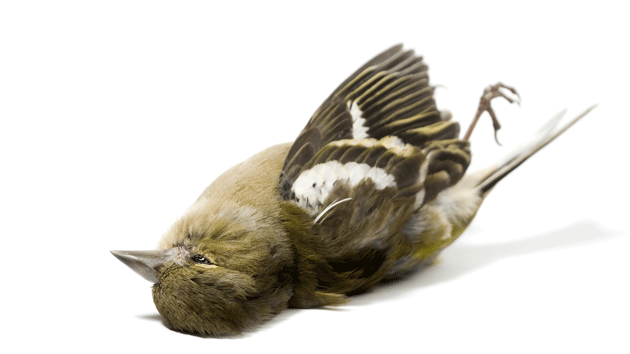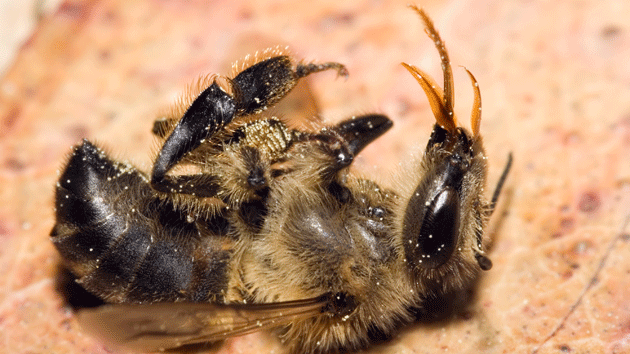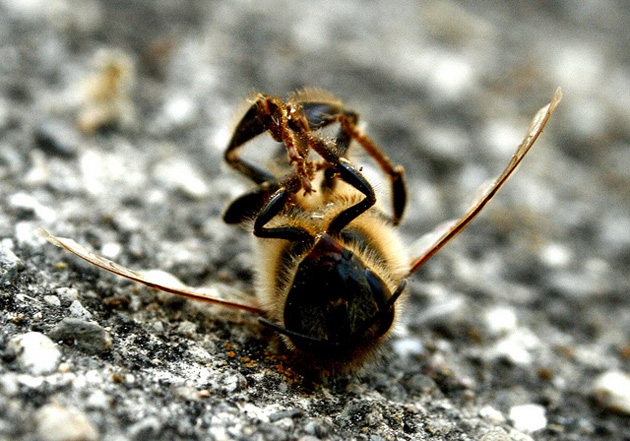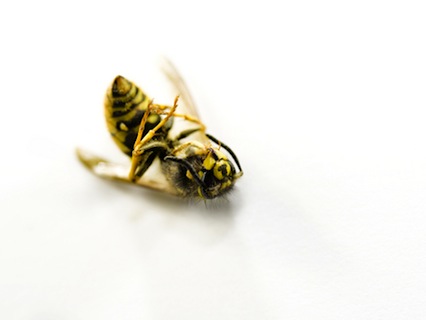
Ah, summer—the season when trillions of corn and soybean plants tower horizon-to-horizon in the Midwest. All told, US farmers planted more than 170 million acres in these two crops this year—a combined landmass roughly equal in size to the state of Texas. That’s great news for the companies that turn corn and soy into livestock feed, sweeteners, and food additives; but not so great for honeybees, wild pollinating insects like bumblebees, and birds.
That’s because these crops—along with other major ones like alfalfa and sunflower—are widely treated with pesticides called neonicotinoids. Made by European chemical giants Bayer and Syngenta, these chemicals generate a staggering $2.6 billion in annual revenue worldwide—and have come under heavy suspicion as a trigger of colony collapse disorder and other, less visible, ecological calamities.
Last year, the European Union imposed a two-year ban on the chemicals, pending more study of their effects on pollinators. The US Environmental Protection Agency—which originally approved the products through a highly dubious process I laid out here—has stood by these ubiquitous pesticides.
Meanwhile, damning research piles up.
• In a study (press release here) that came out in early July and was published in the peer-reviewed journal Functional Ecology, UK researchers outfitted bumblebees with radio-frequency identification tags, dosed some of them with levels of neonics equal to what they might find in a treated field, and set them outside to observe their foraging behavior. The results suggest that the pesticides impair bees’ learning ability: Bees from untreated colonies improved their pollen-collecting ability as they learned to forage, while their neonic-exposed counterparts saw their pollen collection dwindle with time. The takeaway is similar to that of another bumblebee study (my summary here), this one by a different set of UK researchers and published by Nature in 2012. Bad foraging makes bee colonies more vulnerable to a host of threats that confront them: loss of habitat, parasitic mites, and viruses.
• Another study, also released in July, adds weight to the concern that neonics aren’t just harming insects, but also birds. In this one, published in Nature and well-summarized by National Geographic, scientists looked at neonic concentrations in water and bird populations over time on Dutch farmland. They found that in the areas with relatively high concentrations of a common neonic called imidacloprid, bird populations “tended to decline by 3.5 per cent on average annually.” The evidence is circumstantial—they proved that neonics are correlated with, but not the cause of, bird declines. But the case is pretty damning: The declines began in the mid-’90s, when neonics were introduced; and the correlation with neonic concentrations held up when the researchers controlled for other factors that could cause bird decline, like changes in crop type and amount of fertilizer used. The authors conclude that neonics may have “cascading effects” on ecosystems—by poisoning insects en masse, they harm the other species that feed on them, including birds. In that way, neonics are reminiscent of the “persistent insecticides in the past”—a reference to the harsh, now-banned chemicals like DDT that Rachel Carson thundered against in her seminal 1962 book Silent Spring.
• The Silent Spring analogy got a depressing boost earlier in the summer when a group of European scientists called the Task Force on Systemic Pesticides released a comprehensive analysis of the recent science on neonics’ ecosystem effects. Their conclusion, published in the peer-reviewed Environmental Science and Pollution Research: “Population-level impacts have been demonstrated to be likely at observed environmental concentrations in the field for insect pollinators, soil invertebrates and aquatic invertebrates.” Translation: the stuff is likely not just killing bees, but also earthworms and water bugs like dragonflies. “The evidence is very clear. We are witnessing a threat to the productivity of our natural and farmed environment equivalent to that posed by organophosphates or DDT,” Jean-Marc Bonmatin, of the National Center for Scientific Research (CNRS) in France and one of the 29 international researchers who conducted the four-year assessment, told The Guardian. “Far from protecting food production, the use of neonicotinoid insecticides is threatening the very infrastructure which enables it.”
I asked the Environmental Protection Agency for comment on its neonic stance amid such withering criticism. “The EPA will continue monitoring the open literature and other data sources for further developments on this issue,” the agency replied in a statement. Meanwhile, it is painstakingly reviewing its approval of each of the major neonicitinoid products, the first of which won’t be completed until 2016-’17.














